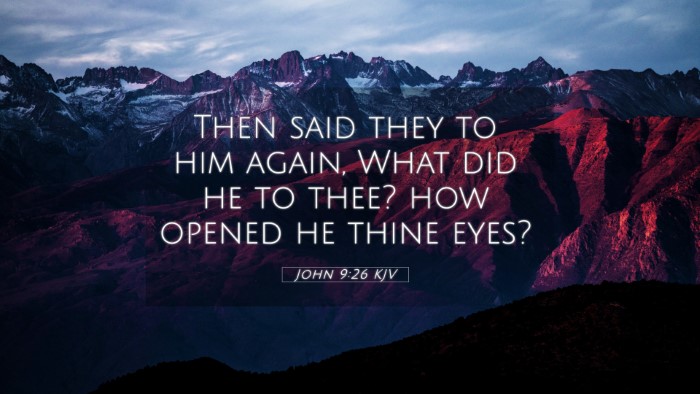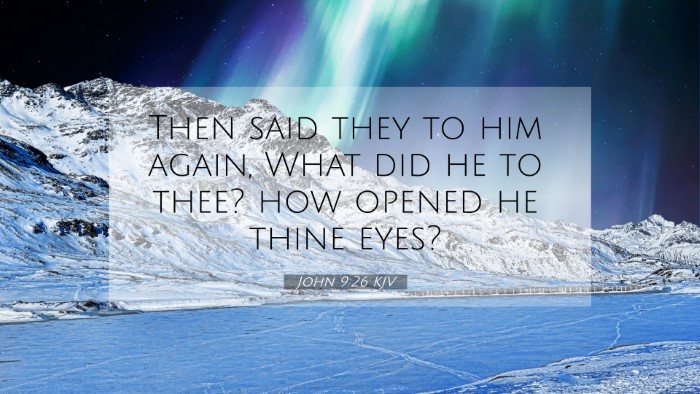Understanding John 9:26
John 9:26 states: "Then said they to him, What did he to thee? how opened he thine eyes?" This verse is pivotal within the narrative of the healing of the blind man, showcasing the inquisitive nature of the Pharisees who were both amazed and skeptical about the miracle performed by Jesus.
Context and Background
The context surrounding John 9:26 is essential for understanding its full significance. This moment occurs after Jesus gives sight to a man born blind, a act that challenges the established religious understanding of the day. The Pharisees' questioning reflects their disbelief and highlights their struggle to reconcile their interpretations of the law with the miraculous works of Jesus.
Thematic Insights
Various commentaries provide rich insights into the meaning of this verse:
- Matthew Henry emphasizes the incredulity of the Pharisees and how their persistent questioning reveals their hardness of heart and resistance to accepting Jesus as the Messiah.
- Albert Barnes notes that the skepticism of the Pharisees illustrates the spiritual blindness that paralleled the physical blindness of the man Jesus healed, prompting readers to reflect on their own spiritual sight.
- Adam Clarke highlights the significance of the miracle as a sign of Jesus’ divine authority and how it served as a cause of division among the Jewish leaders, who were unable to refute the miracle but sought to undermine its implications.
The Nature of Inquiry
The questions posed in this verse reveal not only a desire for information but also an underlying tension. The Pharisees were not merely asking for an explanation; they were probing for a means to discredit Jesus and His actions.
Questions of Faith
Questions about supernatural events often test one's faith. The man's experience and subsequent questioning stand as a testament to the conflict between belief and doubt, emphasizing the broader theme of spiritual illumination versus darkness found throughout the Gospel of John.
Cross-References
This verse connects deeply with several other passages, enriching our understanding through comparative Bible verse analysis:
- John 9:1-7 - The account of Jesus healing the blind man.
- Isaiah 42:7 - The prophecy that the Messiah would give sight to the blind.
- John 8:12 - Jesus declaring Himself as the light of the world.
- Matthew 13:14-15 - Jesus speaking about the spiritual blindness of the people.
- Luke 4:18 - A proclamation of Jesus’ mission that includes healing the blind.
- John 10:25 - Jesus asserting that His works testify of Him.
- 2 Corinthians 4:4 - The god of this world blinding the minds of the unbelieving.
Applying the Insights
In a practical sense, study methods can employ tools for Bible cross-referencing to draw connections and facilitate deeper understanding:
- Bible Concordance: Use a concordance to find words associated with healing and sight throughout Scripture.
- Bible Cross-Reference Guide: This allows for systematic study of how themes of sight and blindness appear in various contexts.
- Cross-Referencing Bible Study: Engage in studies that link Jesus' miracles with Old Testament prophecies and teachings.
Conclusion
John 9:26 serves as a profound reminder of the dynamics of faith and skepticism. By examining the inter-Biblical dialogue present within this passage, one uncovers a rich tapestry of themes regarding belief, the nature of miracles, and the revelation of Jesus as the light that overcomes darkness. Heretofore, links between the miracles of Jesus and prophetic traditions reinforce the harmonious and cohesive nature of Scripture, demonstrating how Bible verses integrate and respond to each other.


